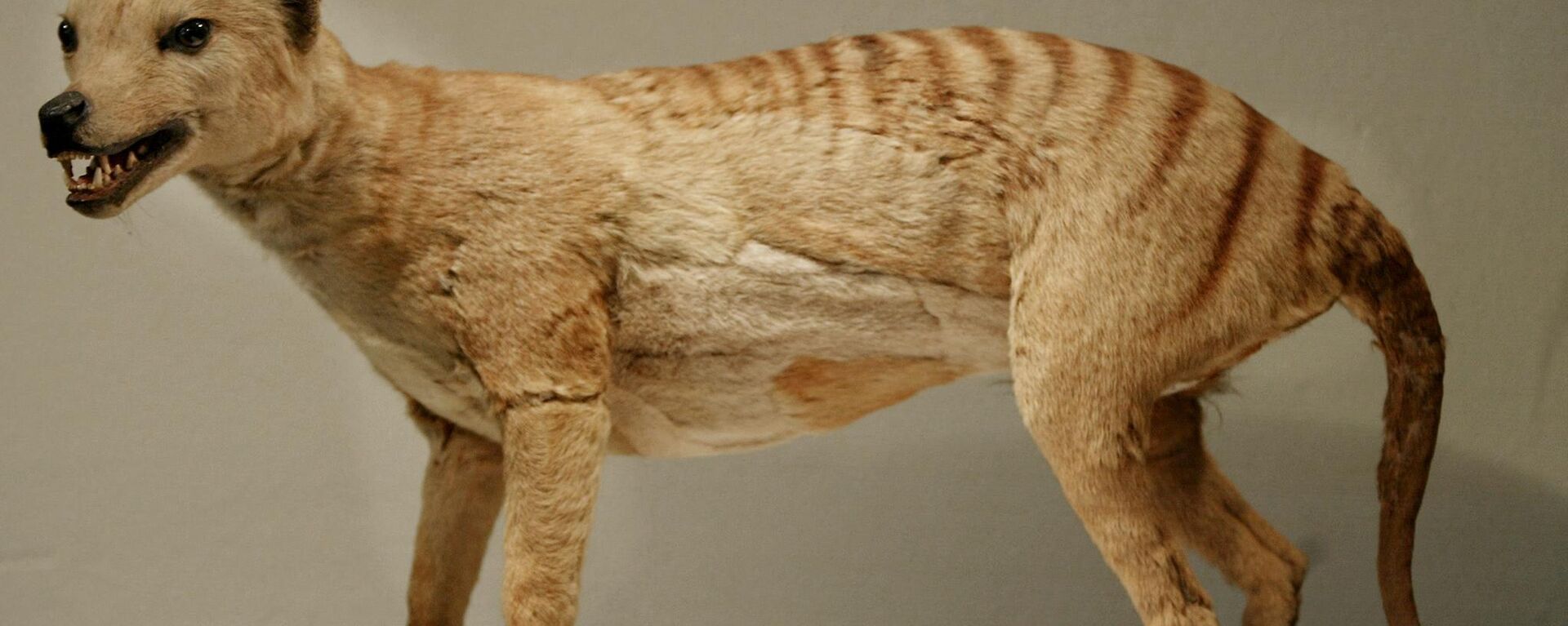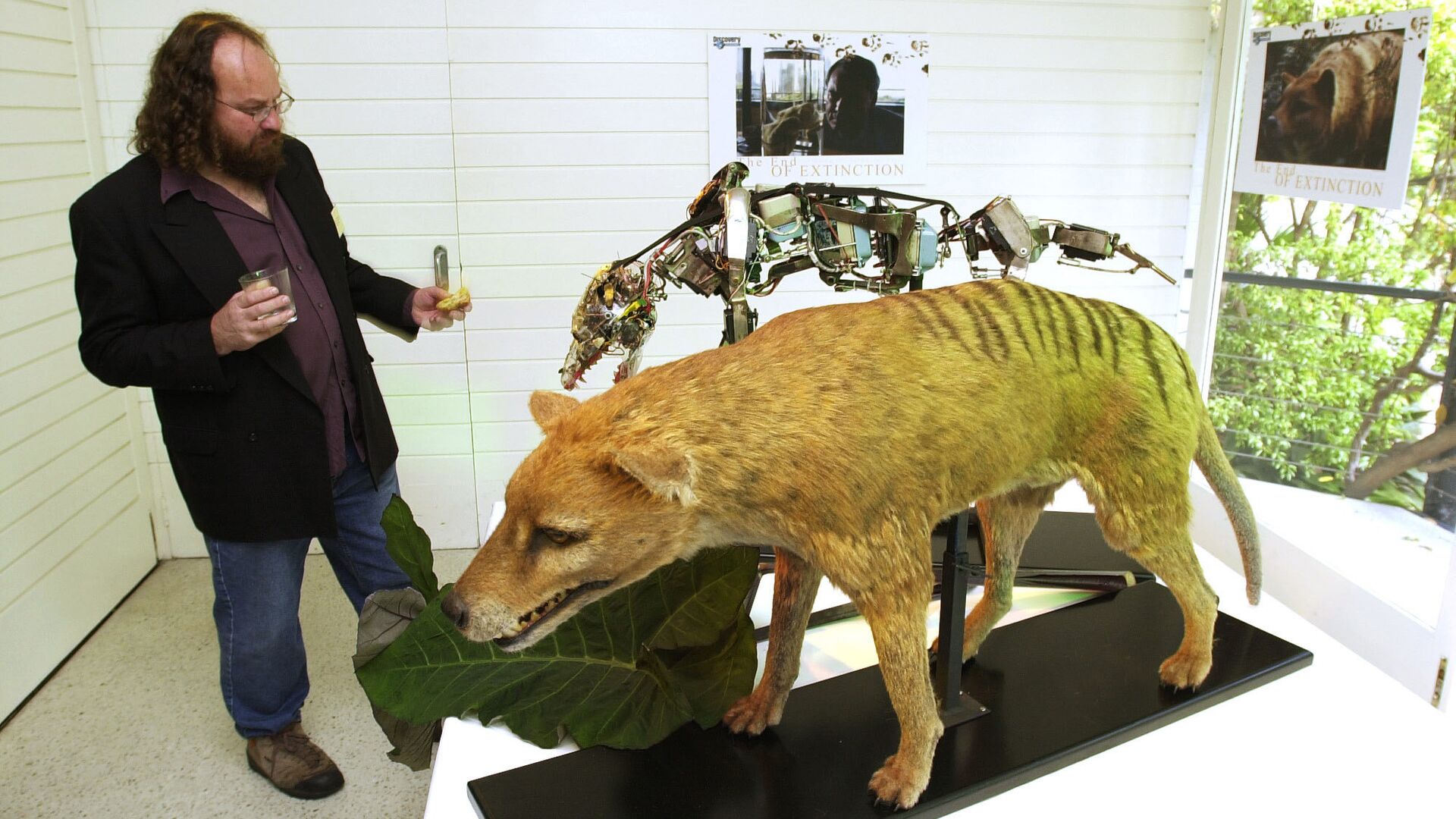https://sputnikglobe.com/20230920/scientists-extract-rna-of-extinct-tasmanian-tiger-1113529894.html
Scientists Extract RNA of Extinct Tasmanian Tiger
Scientists Extract RNA of Extinct Tasmanian Tiger
Sputnik International
This unprecedented feat opens new doors to understanding extinct species and also offers insights into past pandemics and the impact of human activities on species extinction.
2023-09-20T14:04+0000
2023-09-20T14:04+0000
2023-09-20T14:04+0000
beyond politics
science & tech
newsfeed
society
australia
sweden
stockholm
https://cdn1.img.sputnikglobe.com/img/105196/63/1051966379_0:93:2000:1218_1920x0_80_0_0_cb38ff71f36463e0b88f76a40dd43aa9.jpg
Research about the Tasmanian tiger has interested scientists, although it no longer exists. In a significant breakthrough, researchers announced they had extracted RNA (Ribonucleic acid) - genetic material ubiquitous in all living cells from a Tasmanian tiger's parched dermal layers and muscle tissues preserved in a Stockholm museum since 1891.Although not the primary focus of this investigation, the adeptness in extracting, sequencing, and examining aged RNA can significantly bolster other scientists' endeavors to regenerate prehistoric fauna and flora. Additionally, the RNA recovery from ancient viruses may offer crucial insights into understanding past pandemics' origins.In cell biology, the DNA and RNA are biomolecular relatives integral to various cellular processes. DNA manifests as a dual-stranded helix at the core of the genetic framework, serving as the primary repository of an organism's genetic blueprint. RNA emerges as a single-stranded entity entrusted with transmitting and executing genetic directives emanating from DNA.It orchestrates the intricate process of protein synthesis, an imperative underpinning an organism's vitality, and it further exerts regulatory influence over cellular metabolic processes.Questions loomed regarding the viability of RNA within the prescribed parameters of room temperature enclosure within a cupboard, reflective of the conditions under which these remains were conserved.The preserved remains housed at the Swedish Natural History Museum exhibited a condition reminiscent of an incomplete mummified state characterized by bone, muscle tissues, and skin preservation. However, the internal organs were lost.Aside from distinctive tiger-esque stripes adorning its back, the Tasmanian tiger bore a striking likeness with a wolf. The onset of human habitation in Australia some 50,000 years ago triggered a considerable demographic downturn of the animal.Covertly, a wave of "de-extinction" ventures has been set in motion, all with a common goal: the potential resurrection of specific extinct species, including the dodo, Tasmanian tiger, and woolly mammoth.In the past few years, for research purposes, scientists have retrieved plant and animal DNAs of extinct species dating back two million years. However, this landmark study signals the foremost advancement of RNA extraction from non-existent species.
https://sputnikglobe.com/20221205/lost-remains-of-last-known-tasmanian-tiger-found-at-museum-1105049275.html
australia
sweden
stockholm
Sputnik International
feedback@sputniknews.com
+74956456601
MIA „Rossiya Segodnya“
2023
Chimauchem Nwosu
https://cdn1.img.sputnikglobe.com/img/07e7/09/01/1113046371_0:99:1536:1635_100x100_80_0_0_9c5c627283eca931c39fe4852bbb301c.jpg
Chimauchem Nwosu
https://cdn1.img.sputnikglobe.com/img/07e7/09/01/1113046371_0:99:1536:1635_100x100_80_0_0_9c5c627283eca931c39fe4852bbb301c.jpg
News
en_EN
Sputnik International
feedback@sputniknews.com
+74956456601
MIA „Rossiya Segodnya“
Sputnik International
feedback@sputniknews.com
+74956456601
MIA „Rossiya Segodnya“
Chimauchem Nwosu
https://cdn1.img.sputnikglobe.com/img/07e7/09/01/1113046371_0:99:1536:1635_100x100_80_0_0_9c5c627283eca931c39fe4852bbb301c.jpg
thylacine, tasmanian tiger, carnivorous marsupial, extinct species, rna extraction, genetic material, dna, deoxyribonucleic acid, polymer, genetic blueprints, prehistoric fauna, ancient viruses, pandemics origins, rna sequencing, cellular processes, protein synthesis, vitality, metabolic processes, room temperature enclosure, cupboard preservation, mummified state, bone preservation, muscle tissues, skin preservation, evolutionary geneticist, love dalen, demographic downturn, european colonizers, menace to livestock, de-extinction, dodo, woolly mammoth, gene editing, extinct animals.
thylacine, tasmanian tiger, carnivorous marsupial, extinct species, rna extraction, genetic material, dna, deoxyribonucleic acid, polymer, genetic blueprints, prehistoric fauna, ancient viruses, pandemics origins, rna sequencing, cellular processes, protein synthesis, vitality, metabolic processes, room temperature enclosure, cupboard preservation, mummified state, bone preservation, muscle tissues, skin preservation, evolutionary geneticist, love dalen, demographic downturn, european colonizers, menace to livestock, de-extinction, dodo, woolly mammoth, gene editing, extinct animals.
Scientists Extract RNA of Extinct Tasmanian Tiger
Scientists have achieved a monumental breakthrough in genetic research, successfully extracting RNA from a preserved Tasmanian tiger specimen. This unprecedented feat opens new doors to understanding extinct species and also offers insights into past pandemics and the impact of human activities on species' extinction.
Research about the Tasmanian tiger has interested scientists, although it no longer exists. In a significant breakthrough, researchers announced they had extracted RNA (Ribonucleic acid) - genetic material ubiquitous in all living cells from a Tasmanian tiger's parched dermal layers and muscle tissues preserved in a Stockholm museum since 1891.
Although not the primary focus of this investigation, the adeptness in extracting, sequencing, and examining aged RNA can significantly bolster other scientists' endeavors to regenerate prehistoric fauna and flora. Additionally, the RNA recovery from ancient viruses may offer crucial insights into understanding past pandemics' origins.
"RNA sequencing gives you a taste of the real biology and metabolism regulation that was happening in the cells and tissues of the Tasmanian tigers before they went extinct," noted geneticist and bioinformatician Emilio Marmol Sanchez of the Center for Palaeogenetics and SciLifeLab in Sweden, lead author of the study that was published in the journal Genome Research.
In cell biology, the DNA and RNA are biomolecular relatives integral to various cellular processes. DNA manifests as a dual-stranded helix at the core of the genetic framework, serving as the primary repository of an organism's genetic blueprint. RNA emerges as a single-stranded entity entrusted with transmitting and executing genetic directives emanating from DNA.
It orchestrates the intricate process of protein synthesis, an imperative underpinning an organism's vitality, and it further exerts regulatory influence over cellular metabolic processes.

5 December 2022, 12:42 GMT
Questions loomed regarding the viability of RNA within the prescribed parameters of room temperature enclosure within a cupboard, reflective of the conditions under which these remains were conserved.
The preserved remains housed at the Swedish Natural History Museum exhibited a condition reminiscent of an incomplete mummified state characterized by bone, muscle tissues, and skin preservation. However, the internal organs were lost.
"Most researchers have thought that RNA would only survive for a very short time - like days or weeks - at room temperature. This is likely true when samples are wet or moist, but apparently not the case when they are dried," said evolutionary geneticist Love Dalen of the Center for Palaeogenetics.
Aside from distinctive tiger-esque stripes adorning its back, the Tasmanian tiger bore a striking likeness with a wolf. The onset of human habitation in Australia some 50,000 years ago triggered a considerable demographic downturn of the animal.
The arrival of European colonizers in the 18th century brought a dark chapter for the dwindling thylacine communities in Tasmania. In the aftermath, a reward system was instituted against the animals following their designation as a menace to livestock.
The last documented Tasmanian tiger breathed its last in a Tasmanian zoo in 1936, just two months after the creatures were declared as protected.
Covertly, a wave of
"de-extinction" ventures has been set in motion, all with a common goal: the potential resurrection of specific extinct species, including the dodo, Tasmanian tiger, and woolly mammoth.
"The story of the thylacine's demise is in a sense one of the most well-documented and proven human-driven extinction events... Although we remain skeptical about the possibility of actually recreating an extinct species... we do advocate for more research on the biology of these extinct animals,” Marmol explained.
In the past few years, for research purposes, scientists have retrieved plant and animal DNAs of extinct species dating back two million years. However, this landmark study signals the foremost advancement of RNA extraction from non-existent species.




